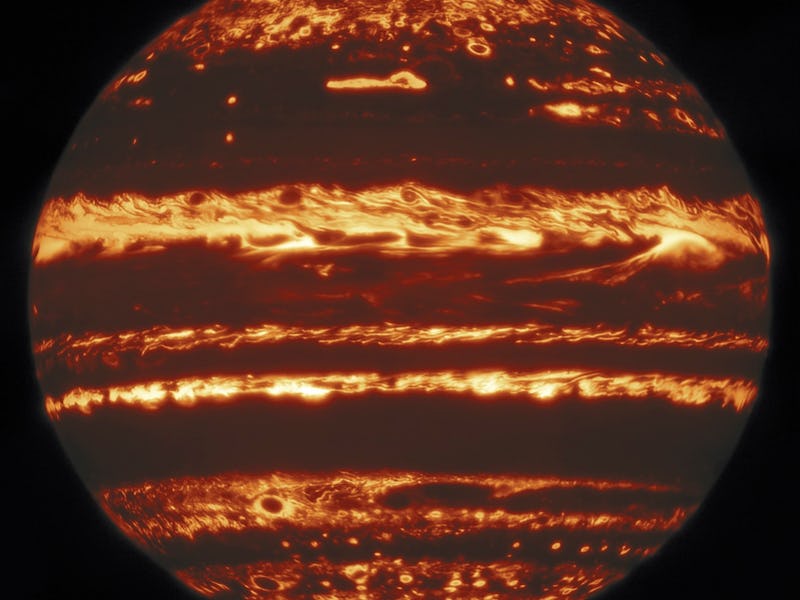Highest resolution images of Jupiter reveal its fiery storms in great detail
The final image is a mosaic of nine different observations.

Jupiter's storms, including its famous Giant Red Spot, are made up of layers of gas that shift and tangle with swirling winds and a layer of dense clouds. Taken all together, they shroud the solar system's largest planet in mystery.
New images captured by the Gemini North Telescope reveal the tremulous, stormy world of Jupiter in all its fiery glory, and unlocking new data on the gas giant's lightning strikes and deep clouds.
The findings from the images were published this week in The Astrophysical Journal Supplement Series.
Using an intricate technique called 'lucky imaging,' the team of researchers behind the new images spent three years collecting observations of Jupiter, resulting in the highest resolution images of the planet ever obtained from Earth.
Lucky imaging is when a telescope captures a large number of images in a row, with short exposure time, and only the sharpest ones are selected, depending on the stability of Earth's atmosphere.
Gemini captured the highest resolution images of Jupiter from Earth.
The resulting image shows Jupiter as a giant, carved out Halloween pumpkin, bursting with its violent winds in a fiery swirl that goes around the planet. The final image was compiled from a mosaic of nine separate observations.
Thick clouds appear dark in the infrared maps, while clearings appear bright.
“These images rival the view from space.”
The longer wavelength infrared light of the Gemini telescope goes through the thin haze of Jupiter's atmosphere, but is obscured by thicker clouds high in the atmosphere. That's why the warm, deep layers of the planet's atmosphere glow through the gaps of its thick cloud cover.
“These images rival the view from space,” Michael Wong, a researcher at the University of California Berkeley, who led the team behind the new images, says in a statement. “The Gemini data were critical because they allowed us to probe deeply into Jupiter’s clouds on a regular schedule.”
The researchers then combined the new images with observations by the Hubble Space Telescope and the Juno spacecraft of Jupiter in order to better understand the planet's violent storms.
These violent storms, like the Great Red Spot, and other, high pressure, anticyclones are part of what makes Jupiter stand out, beyond its heavyweight crown as the largest planet by a long shot.
Previous observations of the Great Red Spot revealed dark spots, which researchers had interpreted as different variations in the color of the clouds. However, the new observations revealed that these dark spots are actually gaps in the cloud cover.
The gaps appeared as bright infrared hotspots. If they had been thick clouds, then the infrared glow, from Jupiter’s internal heat, would have been blocked by them.
By combining the three sets of data, the researchers were also able to investigate the structure of the clouds. They found that the storms' lightning strikes, and some of the largest storm systems that create them, are formed in and around large convective cells over deep clouds of water ice and liquid, according to the researchers.
“Scientists track lightning because it is a marker of convection, the turbulent mixing process that transports Jupiter's internal heat up to the visible cloud tops,” Wong says. “Ongoing studies of lightning sources will help us understand how convection on Jupiter is different from or similar to convection in the Earth's atmosphere.”
Abstract: Imaging observations of Jupiter with high spatial resolution were acquired beginning in 2016, with a cadence of 53 days to coincide with atmospheric observations of the Juno spacecraft during each perijove pass. The Wide Field Camera 3 (WFC3) aboard the Hubble Space Telescope (HST) collected Jupiter images from 236 to 925 nm in 14 filters. The Near-Infrared Imager (NIRI) at Gemini North imaged Jovian thermal emission using a lucky-imaging approach (co-adding the sharpest frames taken from a sequence of short exposures), using the M' filter at 4.7 μm. We discuss the data acquisition and processing and an archive collection that contains the processed WFC3 and NIRI data (doi:10.17909/T94T1H). Zonal winds remain steady over time at most latitudes, but significant evolution of the wind profile near 24°N in 2016 and near 15°S in 2017 was linked with convective superstorm eruptions. Persistent mesoscale waves were seen throughout the 2016–2019 period. We link groups of lightning flashes observed by the Juno team with water clouds in a large convective plume near 15°S and in cyclones near 35°N–55°N. Thermal infrared maps at the 10.8 micron wavelength obtained at the Very Large Telescope show consistent high brightness temperature anomalies, despite a diversity of aerosol properties seen in the HST data. Both WFC3 and NIRI imaging reveal depleted aerosols consistent with downwelling around the periphery of the 15°S storm, which was also observed by the Atacama Large Millimeter/submillimeter Array. NIRI imaging of the Great Red Spot shows that locally reduced cloud opacity is responsible for dark features within the vortex. The HST data maps multiple concentric polar hoods of high-latitude hazes.